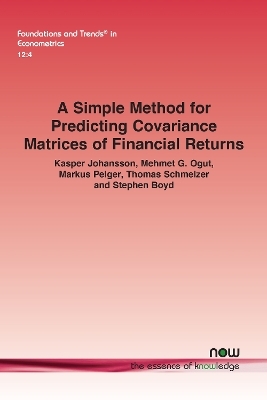
A Simple Method for Predicting Covariance Matrices of Financial Returns
Seiten
2023
now publishers Inc (Verlag)
978-1-63828-308-9 (ISBN)
now publishers Inc (Verlag)
978-1-63828-308-9 (ISBN)
Makes three contributions: proposes a new method for predicting the time-varying covariance matrix of a vector of financial returns; proposes a new method for evaluating a covariance predictor, by considering the regret of the log-likelihood over some time period such as a quarter; an extensive empirical study of covariance predictors.
A Simple Method for Predicting Covariance Matrices of Financial Returns makes three contributions. First, it proposes a new method for predicting the time-varying covariance matrix of a vector of financial returns, building on a specific covariance estimator suggested by Engle in 2002. The second contribution proposes a new method for evaluating a covariance predictor, by considering the regret of the log-likelihood over some time period such as a quarter. The third contribution is an extensive empirical study of covariance predictors. The authors compare their method to other popular predictors, including rolling window, exponentially weighted moving average (EWMA) and generalized autoregressive conditional heteroscedastic (GARCH) type methods. After an introduction, Section 2 describes some common predictors, including the one that this method builds on. Section 3 introduces the proposed covariance predictor. Section 4 discusses methods for validating covariance predictors that measure both overall performance and reactivity to market changes. Section 5 describes the data used in the authors’ first empirical studies and the results are provided in Section 6. The authors then discuss some extensions of and variations on the method, including realized covariance prediction (Section 7), handling large universes via factor models (Section 8), obtaining smooth covariance estimates (Section 9), and using the authors’ covariance model to generate simulated returns (Section 10).
A Simple Method for Predicting Covariance Matrices of Financial Returns makes three contributions. First, it proposes a new method for predicting the time-varying covariance matrix of a vector of financial returns, building on a specific covariance estimator suggested by Engle in 2002. The second contribution proposes a new method for evaluating a covariance predictor, by considering the regret of the log-likelihood over some time period such as a quarter. The third contribution is an extensive empirical study of covariance predictors. The authors compare their method to other popular predictors, including rolling window, exponentially weighted moving average (EWMA) and generalized autoregressive conditional heteroscedastic (GARCH) type methods. After an introduction, Section 2 describes some common predictors, including the one that this method builds on. Section 3 introduces the proposed covariance predictor. Section 4 discusses methods for validating covariance predictors that measure both overall performance and reactivity to market changes. Section 5 describes the data used in the authors’ first empirical studies and the results are provided in Section 6. The authors then discuss some extensions of and variations on the method, including realized covariance prediction (Section 7), handling large universes via factor models (Section 8), obtaining smooth covariance estimates (Section 9), and using the authors’ covariance model to generate simulated returns (Section 10).
1. Introduction
2. Some Common Covariance Predictors
3. Combined Multiple Iterated EWMAs
4. Evaluating Covariance Predictors
5. Data Sets and Experimental Setup
6. Results
7. Realized Covariance
8. Large Universes
9. Smooth Covariance Predictions
10. Simulating Returns
11. Conclusions
Acknowledgements
References
| Erscheinungsdatum | 28.11.2023 |
|---|---|
| Reihe/Serie | Foundations and Trends® in Econometrics |
| Verlagsort | Hanover |
| Sprache | englisch |
| Maße | 156 x 234 mm |
| Gewicht | 151 g |
| Themenwelt | Wirtschaft ► Volkswirtschaftslehre ► Ökonometrie |
| ISBN-10 | 1-63828-308-7 / 1638283087 |
| ISBN-13 | 978-1-63828-308-9 / 9781638283089 |
| Zustand | Neuware |
| Haben Sie eine Frage zum Produkt? |
Mehr entdecken
aus dem Bereich
aus dem Bereich
Übungsaufgaben – Fallstudien – Lösungen
Buch | Softcover (2022)
De Gruyter Oldenbourg (Verlag)
CHF 34,90
mit Aufgaben, Klausuren und Lösungen
Buch | Softcover (2023)
UTB (Verlag)
CHF 34,85
Set aus Lehr- und Arbeitsbuch
Buch | Softcover (2022)
De Gruyter Oldenbourg (Verlag)
CHF 49,95


